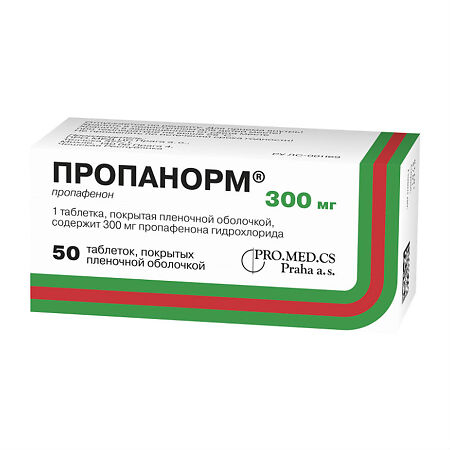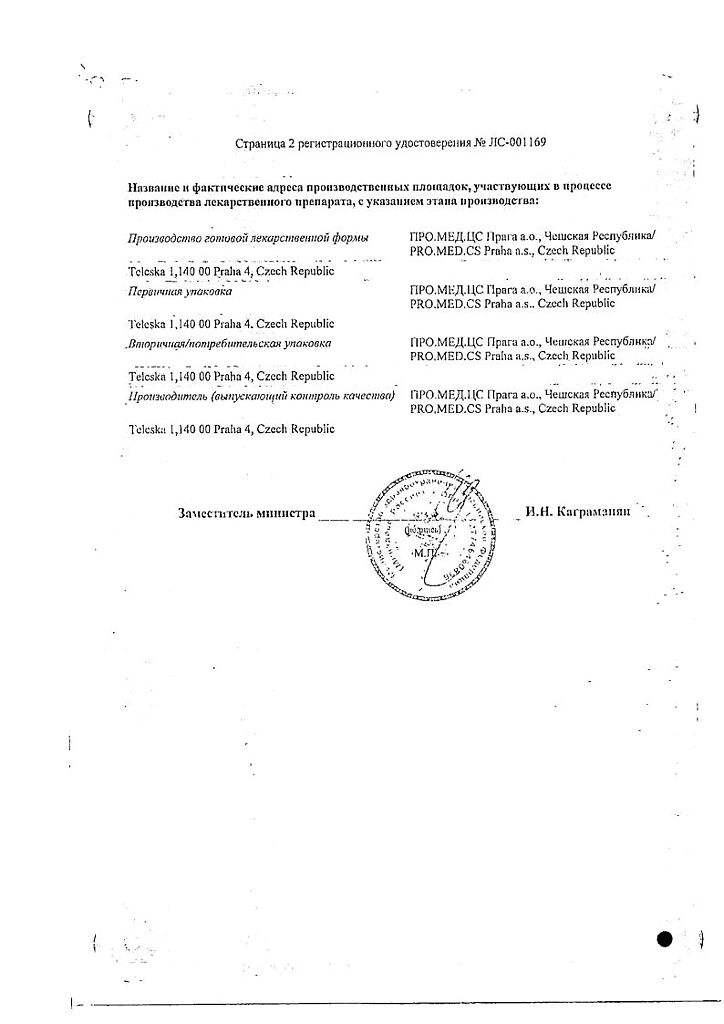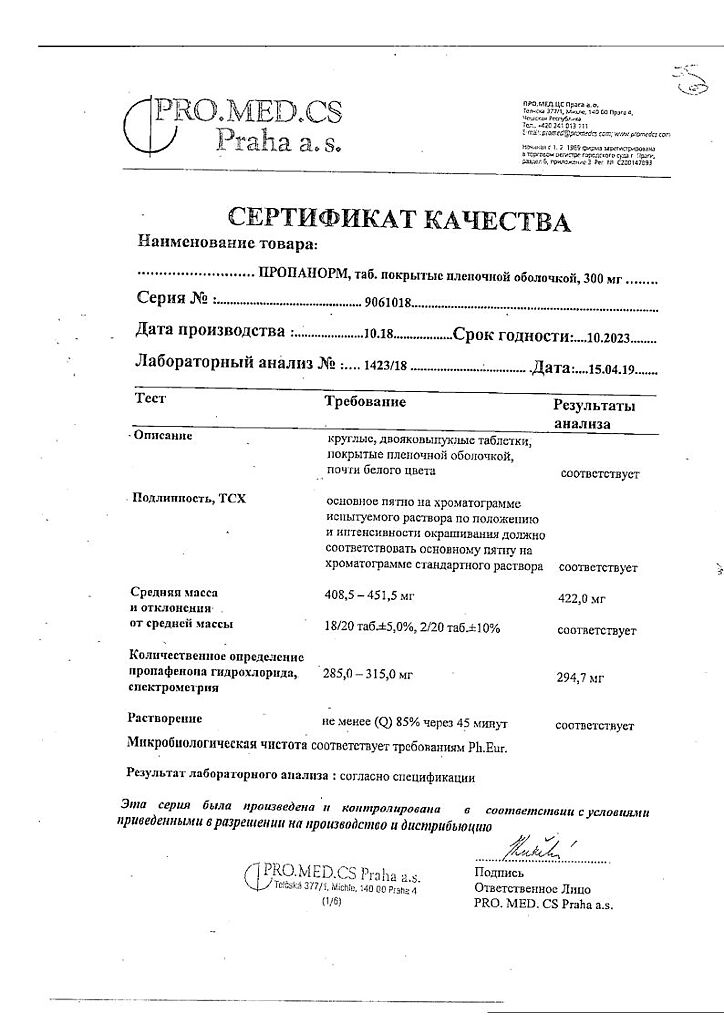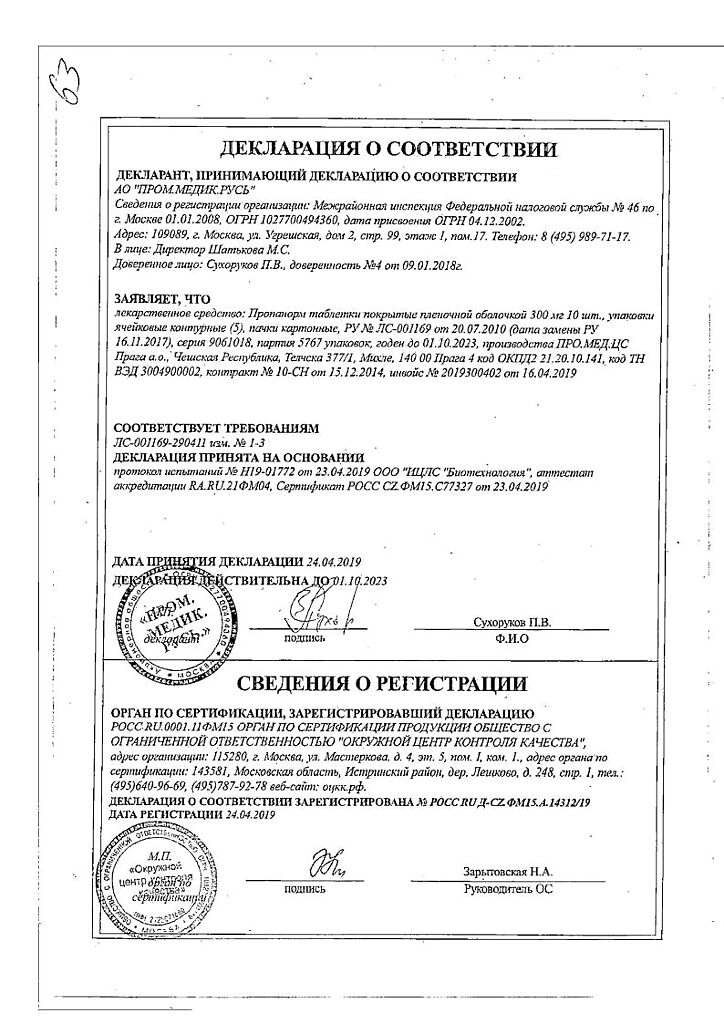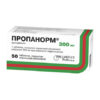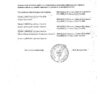No products in the cart.
Propanorm, 300 mg 50 pcs
€1.00
Out of stock
(E-mail when Stock is available)
Description
A class IC antiarrhythmic drug, blocks fast sodium channels.
It has weak ?-adrenoblocking activity (corresponds to about 1/40 part of the activity of propranololol) and m-cholinoblocking effect. Antiarrhythmic effect is based on local anesthetic and direct membrane stabilizing effect on myocardiocytes as well as on blockade of adrenergic ?-adrenoreceptors and calcium channels.
The local anesthetic action corresponds approximately to the activity of procaine.
Propafenone, by blocking fast sodium channels, causes a dose-dependent decrease in the rate of depolarization and inhibits phase 0 action potential and its amplitude in Purkinje and ventricular contractile fibers, inhibits automatism. Slows conduction along Purkinje fibers.
Longens conduction time in the sinoatrial node and atria. The use of propafenone results in prolongation of the PQ interval and extension of the QRS complex (15 to 25) on the ECG, as well as the NA and HV intervals on the histogram.
Inhibiting conduction, the drug prolongs the effective refractory period in the atria, AV node, accessory bundles, and, to a lesser extent, the ventricles. No significant changes in the QT interval are observed.
The electrophysiological effects are more pronounced in ischemic than in normal myocardium. It has a negative inotropic effect, which is usually seen when left ventricular ejection fraction decreases below 40%.
The action of the drug starts 1 hour after oral administration, reaches a maximum of 2-3 hours and lasts for 8-12 hours.
Indications
Indications
Prevention and treatment of supraventricular and ventricular extrasystoles.
Prevention and treatment of paroxysmal rhythm disturbances (supraventricular – atrial fibrillation and flutter, Wolff-Parkinson-White syndrome).
Prevention and treatment of atrioventricular tachycardia.
Prevention of sustained monomorphic ventricular tachycardia.
Pharmacological effect
Pharmacological effect
Class IC antiarrhythmic drug, blocks fast sodium channels.
It has weak β-adrenergic blocking activity (corresponding to approximately 1/40 of the activity of propranolol) and an m-anticholinergic effect. The antiarrhythmic effect is based on the local anesthetic and direct membrane-stabilizing effect on myocardiocytes, as well as on the blockade of adrenergic β-adrenergic receptors and calcium channels.
The local anesthetic effect approximately corresponds to the activity of procaine.
Propafenone, by blocking fast sodium channels, causes a dose-dependent decrease in the rate of depolarization and inhibits phase 0 of the action potential and its amplitude in Purkinje fibers and contractile fibers of the ventricles, and inhibits automaticity. Slows down conduction along Purkinje fibers.
Extends conduction time through the sinoatrial node and atria. When using propafenone, the PQ interval lengthens and the QRS complex expands (from 15 to 25) on the ECG, as well as the AH and HV intervals on the histogram.
By slowing conduction, the drug lengthens the effective refractory period in the atria, AV node, accessory bundles, and, to a lesser extent, the ventricles. There are no significant changes in the QT interval.
Electrophysiological effects are more pronounced in ischemic than in normal myocardium. It has a negative inotropic effect, which usually manifests itself when the left ventricular ejection fraction decreases below 40%.
The effect of the drug begins 1 hour after oral administration, reaches a maximum after 2-3 hours and lasts 8-12 hours.
Special instructions
Special instructions
During the course of treatment, especially at the beginning of therapy, ECG monitoring is necessary.
It is recommended to begin treatment in a hospital setting, since the risk of arrhythmogenic effects associated with the use of propafenone is increased.
Propanorm should be used under the control of blood electrolyte balance (especially potassium concentration) and ECG; The activity of liver transaminases should be periodically determined.
In the treatment of ventricular arrhythmias, propafenone is more effective than class IA and IB antiarrhythmic drugs.
Indications and dose must be determined especially carefully for patients with an installed pacemaker.
It is necessary to conduct clinical and laboratory monitoring of patients undergoing long-term treatment with anticoagulants and hypoglycemic drugs while using Propanorm.
If during treatment sinoatrial blockade or AV block of the third degree, or frequently recurring extrasystole are noted, the treatment must be interrupted.
Considering the possibility of proarrhythmogenic effects, the drug is recommended to be used only as directed and under the supervision of a physician.
– Use for liver dysfunction: In patients with liver failure, the bioavailability of propafenone increases by 70%; in such patients it is recommended to reduce the dose and regularly monitor laboratory parameters. In case of liver dysfunction (cumulation is possible), Propanorm is used in doses of 20-30% of the usual dose.
– Use for impaired renal function: In case of impaired renal function (creatinine clearance < 10 ml/min), the initial dose is 50% of the original.
– Impact on the ability to drive vehicles or operate machinery. During the treatment period, it is necessary to refrain from driving vehicles and engaging in potentially hazardous activities that require increased concentration and speed of psychomotor reactions.
Active ingredient
Active ingredient
Propaphenone
Composition
Composition
1 film-coated tablet contains:
Propafenone hydrochloride 300 mg, which corresponds to the content of propafenone 271.05 mg.
Excipients:
Microcrystalline granulated cellulose,
corn starch,
copovidon,
sodium croscarmellose,
magnesium stearate,
sodium lauryl sulfate,
hypromellose 5,
macrogol 6000,
titanium dioxide,
emulsion of dimethicone with silicon dioxide.
Pregnancy
Pregnancy
The use of propafenone during pregnancy, especially in the first trimester, is possible only when the expected benefit to the mother outweighs the potential risk to the fetus.
Contraindications
Contraindications
Severe forms of chronic heart failure (in the stage of decompensation), uncontrolled chronic heart failure.
Cardiogenic shock (with the exception of arterial hypotension caused by tachycardia and antiarrhythmic shock).
Severe bradycardia.
Severe arterial hypotension.
Sinoatrial block, disruption of intraatrial conduction.
Bundle branch block.
Intraventricular bifascicular block and AV block of II and III degrees (without installing a pacemaker).
SSSU.
“Tachycardia-bradycardia” syndrome.
Myocardial infarction.
Digoxin intoxication.
Hypersensitivity to the components of the drug
The drug should be prescribed with caution in the following cases:
COPD
Myasthenia gravis (including myasthenia gravis).
Heart failure (ejection fraction less than 30%).
Cardiomyopathy.
Arterial hypotension.
Hepatic cholestasis.
Liver and/or renal failure.
Electrolyte disturbances (must be corrected before prescribing propafenone).
Patients over 70 years of age.
Patients with a permanent or temporary pacemaker.
Simultaneous administration with other antiarrhythmic drugs of similar action.
Side Effects
Side Effects
From the cardiovascular system: bradycardia, AV dissociation, ventricular tachyarrhythmias, angina pectoris, worsening of heart failure (in patients with reduced left ventricular function), sinoatrial block, AV block, intraventricular conduction disorders, supraventricular tachyarrhythmias, when taken in high doses – orthostatic hypotension.
From the digestive system: change in taste, dry mouth, bitterness in the mouth, nausea, decreased appetite, feeling of heaviness in the epigastrium, constipation or diarrhea; rarely – liver dysfunction, cholestatic jaundice, cholestasis.
From the side of the central nervous system: headache, dizziness; rarely – blurred vision, diplopia, convulsions.
From the hematopoietic system: leukopenia, agranulocytosis, increased bleeding time, thrombocytopenia, the appearance of antinuclear antibodies.
From the reproductive system: oligospermia, decreased potency.
Allergic reactions: skin rash, itching, exanthema, redness of the skin, urticaria, lupus-like syndrome.
Other: weakness, bronchospasm, hemorrhagic skin rashes.
Interaction
Interaction
You cannot combine Propanorm with lidocaine, because the cardiodepressive effect is enhanced.
With simultaneous use, propafenone increases the concentration of propranolol, metoprolol, digoxin (increases the risk of developing glycoside intoxication), indirect anticoagulants, and cyclosporine in the blood plasma.
When used simultaneously, propafenone enhances the effect of warfarin (by blocking metabolism).
When used simultaneously with beta-blockers, tricyclic antidepressants, the antiarrhythmic effect may be enhanced.
When used simultaneously with local anesthetics, the risk of central nervous system damage increases.
Cimetidine and quinidine, by slowing metabolism, increase the concentration of propafenone in plasma by 20%, rifampicin reduces it.
When used simultaneously with propafenone, amiodarone increases the risk of developing pirouette-type tachycardia.
Drugs that suppress the sinoatrial node and AV node and have a negative inotropic effect, when used simultaneously with propafenone, increase the risk of side effects.
Drugs that inhibit bone marrow hematopoiesis, when used simultaneously with propafenone, increase the risk of myelosuppression.
Overdose
Overdose
When taking a dose twice the daily dose at once, symptoms of intoxication may appear after 1 hour, or at most after a few hours.
Symptoms: persistent decrease in blood pressure, nausea, dry mouth, vomiting, mydriasis, drowsiness, extrapyramidal disorders, confusion, bradycardia, prolongation of the QT interval, intra-atrial and intraventricular conduction disorders, ventricular tachyarrhythmias, paroxysms of polymorphic ventricular tachycardia, sinoatrial block, AV block, asystole, coma, convulsions, delirium, pulmonary edema.
Treatment: gastric lavage, defibrillation, administration of dobutamine, diazepam; if necessary – mechanical ventilation and indirect cardiac massage. Hemodialysis is ineffective.
Storage conditions
Storage conditions
In a dry place, protected from light, at a temperature of 15–25 °C
Shelf life
Shelf life
3 years
Manufacturer
Manufacturer
PRO.MED.CS Prague, Czech Republic
Additional information
| Shelf life | 3 years |
|---|---|
| Conditions of storage | In a dry, light-protected place at 15-25 °C |
| Manufacturer | PRO.MED.CS Prague, Czech Republic |
| Medication form | pills |
| Brand | PRO.MED.CS Prague |
Related products
Buy Propanorm, 300 mg 50 pcs with delivery to USA, UK, Europe and over 120 other countries.

